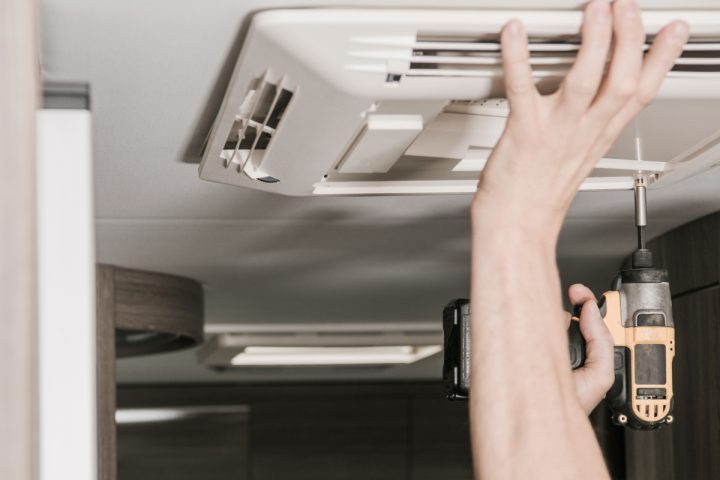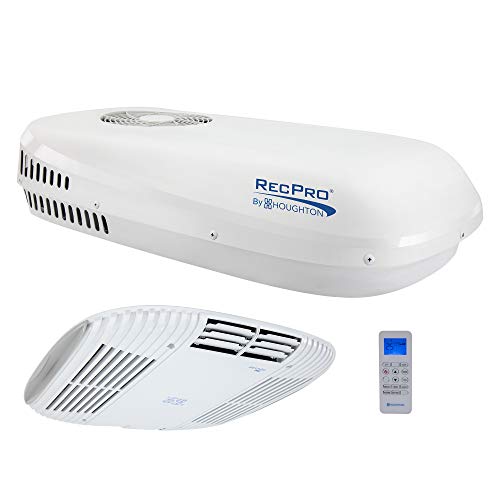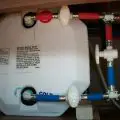Hey! This site is reader-supported and we earn commissions if you purchase products from retailers after clicking on a link from our site.
If you’re in the market for a new air conditioning unit for your RV, then of course you’ll want to get the absolute best one you can for your money
Chosen carefully, the right AC unit could well last you years. For RV owners, they’re an essential part of the experience – after all, without one, those hot days can be unbearable!
We’ve found some of the best RV air conditioners that are available on the market. Hopefully, this list will help you find the one that suits your needs best!

Table of Contents
- RecPro RV Air Conditioner 15K
- RecPro RV Air Conditioner Low Profile 9.5K Non-Ducted
- Dometic Brisk II Rooftop Air Conditioner, 13,500 BTU – Polar White (B57915.XX1C0)
- ASA Electronics ACM135 Advent Air 13,500 BTU Roof Top AC, White
- Dometic Brisk II Rooftop Air Conditioner, 15,000 BTU – Polar White (B59516.XX1C0)
- Coleman 48204C866 Mach 15+ A/C Unit
- Buyer’s Guide
- Start Cooling Off!
- Frequently Asked Questions
RecPro RV Air Conditioner 15K

We purchased this unit because we were looking for an AC that was quiet and would fit into the space we had available.
We also wanted one that could handle the heat and humidity of Florida. This unit has been working great!
It is easy to install and works like a charm. It does take some time to get used to the controls as they are different from any other AC we have owned before. However, once you figure them out, they are pretty simple to operate.
We love the fact that there are no ducts running across the ceiling of our motorhome. There is plenty of room for the unit to run without being obstructed. We also love the fact that it is made in America.
We have had nothing but good experiences with this company. They stand behind their products and make sure that they do what they say they will do. We highly recommend this unit to anyone looking for a quiet, efficient, and affordable AC.
Pros
- Also, a heater – this unit will not only allow you to cool down your motorhome but will also act as a handy heater for the colder months.
- Quiet operation – perfect for those looking for a less noisy way to air condition their motorhome
- Easy to install – make this a great choice for someone looking for an easy method to air condition their motorhome
- Energy efficiency – this unit is energy efficient, which can be great for those looking to conserve power
Cons
- Controls – they can be a little different from controls that you’re used to, so might take some getting used to
- Lacks a junction box – might add some complexity to the installation
Available at
RecPro RV Air Conditioner Low Profile 9.5K Non-Ducted

We purchased this AC because we were looking for a smaller unit that would fit into our RV. We wanted one that was quiet and didn’t use too much electricity.
We don’t have the biggest RV in the world, so a less powerful unit like this seemed like a great choice for us. We also wanted one that could be placed anywhere in the RV without having to worry about running wires. This unit does just that!
It is super easy to install and works great. It is extremely quiet, which is great if you’re trying to have a nap in the cool air! Also, it doesn’t use any more electricity than a standard window AC. We love it!
Pros
- Smaller unit – perfect for those looking for a space-saving air conditioning unit
- Quiet – great if you’re after something that won’t irritate your ears while it’s active!
- Low power usage – this is a lower-powered unit than many others, which can be great if you have to worry about your energy budget
Cons
- Not as powerful as some other units – as a low powered unit, it obviously can’t have the same performance levels as units that draw more power
- No heater – can’t be used to heat your RV in the colder months of the year
Available at
Dometic Brisk II Rooftop Air Conditioner, 13,500 BTU – Polar White (B57915.XX1C0)

We purchased two of these units to replace older units that were no longer working properly. They were delivered within 2 weeks and installed quickly and easily. We couldn’t have asked for an easier time!
The new units perform much better than the old ones did. They are quiet, efficient, and easy to install. They keep our motorhome cool – it’s so nice to be able to relax in a cool room!
We also love that we can use our RV in winter and still be comfortable, as this unit helps us to heat our RV too!
Pros
- Well dampened – the dampening brackets help to cut down on noise caused by vibrations
- High powered operation – at 13,500 BTUs, this unit can do a lot of cooling
- Easy to install – won’t take much effort or time to fit into your RV
- Optional heater – if you’re traveling during cold weather, this might well be a great extra
Cons
- Not the quietest unit – if you’re looking for a low noise air conditioning unit, then you may wish to look elsewhere
- Doesn’t come with a mounting bracket or interior control unit – must be bought separately
Available at
ASA Electronics ACM135 Advent Air 13,500 BTU Roof Top AC, White

We purchased this unit for use as an air conditioner for our new RV. We wanted a unit that would not require any special installation, was easy to install and had good airflow. This unit met all these requirements.
Installation was simple and took less than one hour. There were no problems during the installation process. Once installed, it has been working great. We have used it several times since installing it, and it has performed flawlessly.
We have also noticed that it does keep the RV cooler running. The unit is quiet and has excellent airflow.
Pros
- Extremely easy to install – you won’t need to spend very long installing this unit, and in fact can easily be done in around an hour
- Powerful – at 13,500 BTUs, this unit can do a lot of cooling!
- Quiet operation – won’t annoy you, even at night!
Cons
- Not the highest build quality unit – some users have reported minor issues such as loose/ill-fitting knobs
- Instructions – could do with being a little better written
Available At
Dometic Brisk II Rooftop Air Conditioner, 15,000 BTU – Polar White (B59516.XX1C0)

We purchased this unit because it was recommended by a friend. He said he had used it before, and it worked great. We were skeptical about how much it would cool our motorhome.
However, when we got it installed, we found that it did indeed cool our RV quite effectively. This shouldn’t have surprised us, as it has a 15,000 BTU capacity – it’s more than enough to cool our RV! It has made a hot summer into something we can enjoy in our RV – no more sweltering heat for us!
We also noticed that it was fairly quiet compared to other units we have seen. This was a great bonus for us, as we didn’t want an air conditioner that would be too noisy!
Pros
- Extremely powerful – at 15,000 BTUs, you can be sure that this unit will be able to cool all but the largest spaces with absolute ease!
- Easy to install – you’ll have this unit fitted and operational in practically no time at all!
- Choice of installation – can be installed ducted or non-ducted
Cons
- Needs new controller box and thermostat – unlikely to work well with older analog units
- Doesn’t come with instructions – you’ll need to look up a guide online
Available at
Coleman 48204C866 Mach 15+ A/C Unit

We purchased this unit as an upgrade to our existing air conditioner. The new unit has been working great!
It was easy to install and works perfectly. We were able to get it installed within 2 hours. The installation instructions were clear and concise. There were no problems during the installation process.
The unit is quiet and does not make any noise when running. The unit runs extremely efficiently. It is much quieter than our old unit. The unit is easy to use. You just turn it on and off. It automatically turns itself off after about 4 hours. It shuts down completely after 8 hours.
This saves us a lot of money, of course – but it’s also nice to know that we don’t have to fiddle around with the settings too much. We like to keep things simple! The unit is very energy efficient. It saves us money every month. We would recommend this unit to anyone looking for an upgrade.
Pros
- Heats and cools – contains a heating element, saving you the need of installing a separate heater
- 15,000 BTU – more than enough to keep your RV extremely cool
- Easy to install – as long as you can access the top of your RV easily, installation should be no problem at all!
Cons
- Not the cheapest unit – although, as it comes with a heater, this may make some sense
- Doesn’t come with a thermostat – if you need a new thermostat, you’ll have to buy one separately
Available at
Buyer’s Guide
The following information should help you decide which type of air conditioning system will best suit your needs:
Air Conditioning Types
There are two main types of air conditioners available. These are split systems and window units. Both types have their pros and cons.
Split Systems
Split systems are usually cheaper to purchase and install. They consist of two parts; a compressor and a condenser coil.
The compressor is connected to the condenser coil via a refrigerant line. This means that the compressor is always running, even when the air conditioner isn’t being used.
A fan blows cold air over the condenser coil, cooling it. The cooled air then passes through vents located throughout the inside of the RV and into the living area. The cooled air is blown over the interior walls of the RV, providing additional comfort.
Although they are less expensive than window units, split systems tend to be noisy. If you plan to live in your RV full-time, they may not be ideal for you. However, if you only want to use the air conditioner occasionally, they could be perfect for you.
Window Units
Window units are usually more expensive to purchase and install. Unlike split systems, these units don’t require a compressor. Instead, they contain a small motor that spins a fan.
The fan pushes air over the outside wall of the RV, where it is cooled by the ambient air temperature. The cooled air is then circulated around the RV using vents.
Unlike split systems, window units do not produce any noise while operating. They also provide better ventilation because there are fewer moving parts. Window units are therefore recommended for RVs that will be used frequently.
Which Type Should I Choose?
If you plan to live full time in your RV, choose a window unit. Split systems are too noisy for daily use. If you plan to use the air condition only occasionally, select a split system. They’re easier to install and operate.
How Much Does Air Conditioning Cost?
You’ll pay anywhere from $500-$1,200 for a quality window unit. Prices vary depending on the size of the unit and whether you include a heater. For example, a 10,000 BTU unit costs about $700 without a heater.
You’ll pay between $2,000-$5,000 for a quality split system. Again, prices vary based on the size of the system and whether you get a heater.
How Do I Install An Air Conditioner?
Installing an air conditioner can be tricky. It requires a lot of planning and preparation before installation begins.
Before installing anything, make sure you know what kind of electrical hookup you have (if applicable) and how much power you have available. You’ll also need to know how many outlets you have in your RV.
For window units, you’ll need to determine which side of the RV has the best airflow. Then, place the unit so that it faces this direction. Next, measure the distance from the front of the RV to the nearest outlet. Make sure the unit’s location doesn’t block the outlet. Finally, connect the wires to the appropriate terminals.
For split systems, you’ll need to figure out which part of the RV has the most direct access to the outdoor environment. Place the compressor and condenser coils at the back of the RV. Connect the lines to the correct terminals. Once everything is installed, test the system to ensure it works properly. If it does, turn it on and enjoy!
What Is A BTU?
BTUs stand for British Thermal Unit. A BTU is a measurement of heat energy. It represents the amount of heat required to raise 1 lb of water 1 degree Fahrenheit (ca. -17 °C). In other words, a 10,000-BTU unit would be able to remove 10,000 BTUs per hour.
A typical home uses about 2,000 BTUs per day. An average car engine uses about 5,000 BTUs per minute. Air conditioning units work by removing heat from the inside of your RV. Therefore, the higher the BTU rating, the greater the cooling capacity.
Start Cooling Off!
Air conditioning is essential to living comfortably in your recreational vehicle. Hopefully, this handy guide to the best RV air conditioners will help you to choose the best unit for you!
Frequently Asked Questions
How Do I Clean My RV Air Conditioner Filter?
The easiest way to clean your air conditioner filter is to simply blow it out. To do this, open all windows and doors, turn off the air conditioner, and then open the outside vents.
After doing this, close the vents again and let them sit closed for several hours. This allows any dirt or dust particles to fall onto the ground. Once they have settled, vacuum up the debris.
You can also purchase a special cleaning tool that attaches to the end of a hose. Simply attach the hose to the intake vent, and then connect the other end to the exhaust vent.
Then, press down on the trigger button to force the dirty air through the filter. When done, disconnect the hoses and allow the filters to dry before replacing them.
Do I Need Someone To Install My RV Air Conditioner, Or Can I Do It Myself?
Yes, you can install your RV air conditioner. But, be careful! Installing an air conditioning system requires knowledge and skill.
You’ll need to know how to properly wire everything together. Also, you’ll need to understand how to read and interpret instructions.
If you decide to hire someone else to install your air conditioner, make sure he or she has proper training and certification.
There are many different types of air conditioning systems available. Be sure to choose the right type for your RV.
How Can I Tell If My AC Unit Is Broken?
There are a few things you can check to see if your air conditioner is broken. First, look at the condenser coils. They should be covered with insulation. If they aren’t, then the unit may be leaking refrigerant gas.
Next, look at the power cord. It should fit tightly in its socket. Loose connections will cause the unit to overheat.
Finally, take a good look at the fan blades. The blades should spin freely without binding. If they bind, then the motor may be damaged.




